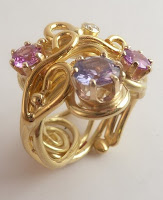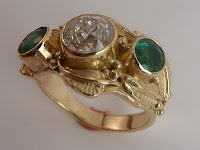
I realize that many people have no clue what goes into the actual production of a custom job for a customer at Daniel R. Spirer Jewelers. So I've decided to document one that I took in this December. I had an old customer come in and tell me that she wanted one of my handmade 22k gold chains (as pictured). However given where gold prices have gone, I discussed with her pricing and she mentioned that she had a gold Krugerrand that she had inherited from her parents and that she felt strongly about being able to use the actual gold from that coin in the necklace if that was possible. I knew it would lower her cost a bit and I told her that I would be happy to try and accommodate her needs if at all possible. This first meeting took about a half hour to complete. She said that she would bring the coin in for me to use shortly.
After she left, I realized that while I knew that Kruggerands were gold, I didn't really know what they were composed of. I assumed (mistakenly, as it turns out) that they were simply pure gold. So I then spent a half hour on the phone with my primary gold supplier who proceeded to tell me that in fact Kruggerands were 22k gold. At first that sounded great because I need 22k gold to make my chains in, but he then informed me that the only alloy they used was copper. Not only would this not produce the color I need, but I knew the metal wouldn't behave properly when I went to fuse the links (I don't use solder in these chains; I simply heat them until they actually are almost at melting point and then fuse them together). We then got into a long discussion about how I would get it to the alloy I would need and I soon realized that it was completely impractical as I would need to get about 3 more ounces of pure gold, alloy it only with silver and then mix her coin in. This was impractical because I only needed a little over an ounce and a half of gold for the chain and I then would have a lot of her metal mixed in with my own that I would have to sit on until I had a need for it (plus she wouldn't get all of her metal back in her chain).
So I realized that I would need to find a refiner who would take her coin and alloy it to pure gold and then send it back to me. It took a few phone calls but I found a guy I bought some other materials from who agreed to do it. Once I got the pure gold back, I could add only the quantity of my own pure gold so that I could make up the specific 22k gold alloy that I needed for the piece. Basically I had now spent about an hour on the phone clarifying all of this.
About a week later, my customer came in with her husband and the coin and the order was placed, with the understanding that, despite the late starting point I would try and have it ready for Christmas (the order was actually placed on December 9). I then had to call and confirm with the refiner that I was sending the coin in to them and to spend a few minutes begging that they would get it back to me as quickly as possible. The piece had to be packed up and shipped overnight to Los Angeles. In the meanwhile, I also had to call my regular gold supplier and order the balance of the 24k gold I would need. I didn't actually get the pure gold back until December 17 (one week before Christmas). Now I had to actually make the chain itself.
In order to make the chain, I first had to melt all of the 24k gold together with the silver and copper that would alloy it down to the 22k gold mix I needed. This is basically taking a really huge flame on my oxy-acetylene torch and heating up a huge mass of gold until it melts, and then sticking a wooden stick in to stir it around until the alloys have blended properly. The stick, of course, catches fire but you just have to kind of ignore it for awhile and try really hard not to singe yourself. With the molten metal in the crucible, while keeping the flame on it the whole time, you have to lift up the crucible and pour it, all at once, into an ingot mold that creates a 3" long extremely thick rod of round wire.
The next step is to roll the rod down to a much thinner gauge wire. A rolling mill is used, the wire is fed into it, and each time you roll it through you crank down the gap a bit to make it smaller. Eventually you have to use smaller and smaller holes to roll it through. After every three or four runs through the mill, the wire has to be annealed (heated until it is red hot) in order to soften it enough so that the metal isn't being stressed as it keeps getting smaller and smaller. But the rolling mills we use actually make square wire not round wire so, eventually, I have to start pulling the wire through a drawplate. This is a bit more complicated. I have to first file the ends of the wire into points and then grab it with a large pair of tongs and physically pull it through progressively smaller holes. Again it has to be annealed regularly, and inevitably it breaks and I end up having to file the ends of, and pull, multiple pieces of wire. Usually in the larger sizes this isn't too hard but as the wire continues to get thinner it eventually reaches the point where the filed ends are so thin that they routinely break off before I can actually get any of the wire through.
Eventually when I reach the point where I have wire the size I actually need I anneal it one more time and then proceed to actually making the chain. Please note that I have now spent about 2 hours with the customer, on the phone with various people, shipping the package, etc. plus about 4-5 hours making the metal and wire. In tomorrow's posting I will continue describing the process.






































